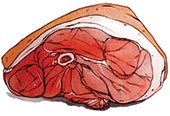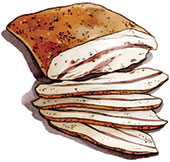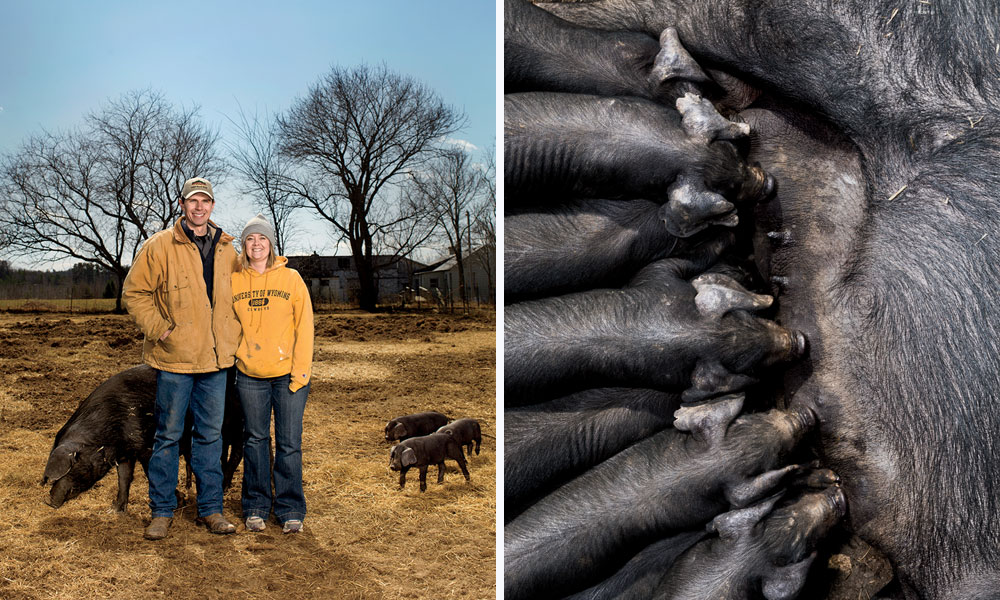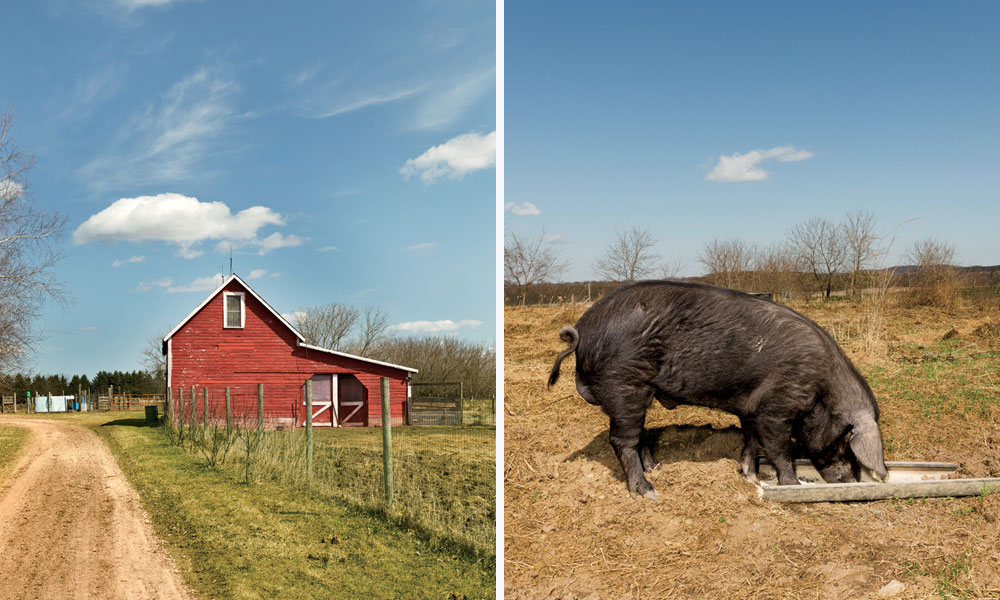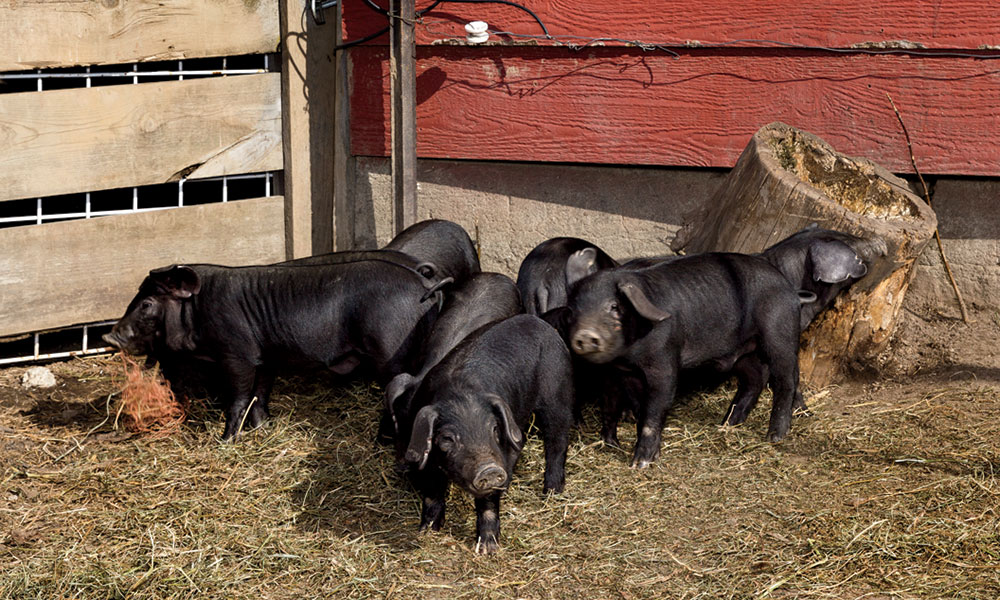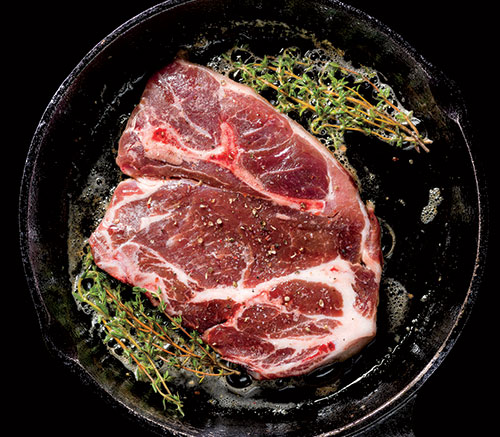Until I got my own pigs, I had pretty much given up on the pork chop. You know the pork chop. The sad pork chop. The one doused in applesauce, or drowned in discount barbecue sauce, or festering in a slow cooker under mushroom soup slopped from a can—anything to moisten meat with all the mouthfeel of a ream of copier paper.
Are you old enough to remember the ads? “Pork. The other white meat.” It wasn’t, of course—the USDA has always classified it as red—but the slogan worked. For a short time, America filled its plates with pork, even as beef consumption dipped.
But something was missing. Flavor, for starters.
The last time I had one of those pork chops was the last time I ate a pig I hadn’t raised.
More and more people want better pork. Different pork. Some want it for the taste; some want it for nutritional and environmental reasons. (The USDA estimates that organic pig production quadrupled between 2001 and 2011.) Some want it for animal-welfare reasons. Most of us still shop at regular grocery stores—but we’re developing an interest in the origins of our oinkers. Where did that pig wallow before it went to hog heaven?
My brother-in-law Mark would jump out of his camo-print recliner and smack you in the mouth if you called him an eco-conscious foodie, but he’s been raising a few pigs in his backyard for several years now. (He and I both live in rural Wisconsin.) When I asked him why, he looked at me with his best concealed-carry stare and said, “Because I want to know where my kid’s food is coming from.”
That’s pretty much it.
That, and he wants pork chops that taste like pork.
The first two pigs I ever owned were “feeders,” meaning they had been weaned and already weighed about 40 pounds the day I brought them home. When I lifted them from the truck, they felt as solid as four-legged medicine balls. The minute their hooves hit the ground, they shoveled their snoots into the dirt and, snuffling and grunting, their tails spinning gleefully, plowed off through the weeds. Amy, my 6-year-old daughter, laughed and, pointing, declared, “That one’s Wilbur!” Then she pointed at the other pig. “And that one’s Cocklebur!”
Farmers will tell you that it’s pretty much always a bad idea to name the animals you plan to eventually butcher. Kneeling beside Amy, I gently explained our plans for those pigs. Several weeks later, some of our city cousins came to visit. Amy showed them the pigs. “That one’s Wilbur and that one’s Cocklebur!” she said, pointing at each in turn. Then she said, “But in October, that one’s Ham and that one’s Bacon!”
Ham and bacon. We never fell out of love with them. Salt and fat cover a multitude of sins.
Most of the offenses to good-tasting pork can be traced to 1980, when the U.S. government issued new dietary guidelines that cast fat as a devil in our diet. Pork producers understandably bred leaner pigs in response. “The Other White Meat” slogan debuted in 1987, and somewhere along the line the pork chop lost its soul.
Today, however, many researchers are questioning whether fat is as bad as we thought: A 2014 Journal of Nutrition study found no association between saturated fatty acid intake and heart attack risk in patients with coronary artery disease. In other words, if that lip-smacking lard isn’t going to make the most vulnerable people keel over, most moderately healthy carnivores should be able to scarf it down safely.
Old-school pork chops are back on the table.
Jim Deutsch is part of the resurrection of pork, and his pigs are happy about it. The day I visit him, it’s freeze-your-spit-before-it-hits-the-ground cold, but the porkers are scampering around a steel-roofed enclosure designed to take maximum advantage of natural light.
“I’d say with raising pigs, the biggest secret is the sun,” says Deutsch, whose farm in Osseo, Wisconsin, is certified organic. “We designed this barn so that in winter the sun reaches all the way in, and in summer it is completely shaded. There’s a gap in the back to let the natural draft provide ventilation. We sell 300 to 400 pigs a year, but you’d never know it, smellwise.”
We stop at a pen housing two boars. They look like oil barrels. Each is packing a set of testicles the size of cantaloupes. “I just put some sows in there this morning,” says Deutsch. One of the boars grunts, and it sounds like a dinosaur burping down a well. Deutsch points to the rear of the pen, which is filled with shredded straw and cornstalks that the pigs have torn from a large, round bale. “It’s called a Swedish deep-bedded system,” explains Deutsch. “They root around in there all day. It keeps them happy—we never have to clip their tails and they never bite each other.” (Closely confined pigs are known to chomp each other’s ears and tails out of boredom.) Several of the pigs have burrowed into the bedding until only their snouts and ears are visible, and they’re snoozing cozily.
Deutsch’s animals are confined, but unlike their factory-farmed cousins, they’re provided with ample room to cavort in the open air. Plus, they have to run the length of the enclosure in order to reach their food and water. All of this movement increases the pigs’ production of myoglobin, a protein that imbues the meat with a ruby hue.
“The meat we get is a lot redder,” says Deutsch. “And that’s part of the education we have to do with people. When they’re cooking a chop, it’ll be done and juicy, but they see that redness, think it’s bloody, and end up cooking it too long.”
I have never raised organic pigs. I raised whatever-ya-got pigs. They ate a little premixed feed from the mill, yes, but mainly my goal was to fatten them as cheaply as possible. In addition to letting them dig in the sod, I threw them fresh nettles, sweet corn, wild grapevines, curdled goat’s milk, and acorns by the wheelbarrowful. I once cut a deal with a local high-end coffee shop to take away all its leftover Sunday brunch. You haven’t seen a happy hog until you’ve witnessed one snarfing a trough of lemon ricotta crepes.
And there’s your hidden value in small-scale homegrown pigs: free entertainment. Why park in front of the TV when you can hang around the pigpen scratching hog backs with a garden rake? They squint up their eyes and squeak and sometimes tip right over with pleasure. One of our favorite family videos is of Amy in her swimsuit, hosing down a batch of young pigs on a hot summer day. As she stands barefoot in the muck, the pigs flop around in their mud bath like hyperactive seals. Once I teed up a pile of windfall apples and let Amy smack them into the pigpen with a softball bat. I then held my younger daughter, Jane, in my lap and we watched from a lawn chair as the pigs barged into each other like bumper cars and fought to devour the fruit shrapnel, the evening air rich with the scent of apple mist as Jane giggled and giggled.
If you’ve got pigs, you don’t need Netflix.



